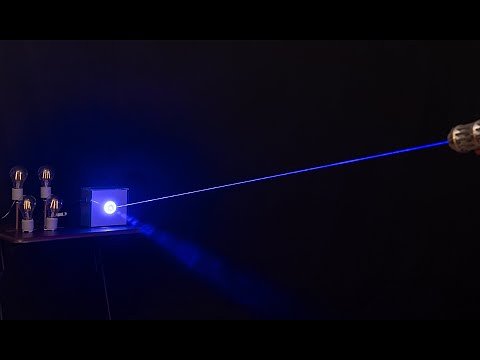
Startup Aims to Beam Power Through Air with Novel Laser Tech
A new company is developing laser-based wireless power transmission, promising efficient energy delivery. But can it overcome the technical hurdles and deliver on its ambitious goals?
Startup Aims to Beam Power Through Air with Novel Laser Tech
By David Patterson
Prime Movr, a nascent technology company, is making waves with its claims of enhanced efficiency in laser-based wireless power transmission. While the idea of beaming energy through the air isn’t new, the company suggests its advancements could unlock a new era of cordless power for drones, remote sensors, and even potentially larger-scale applications. However, a deeper look reveals a landscape of complex technical challenges and fierce competition.
Prime Movr announced its progress via a recent press release, touting improvements in “optical collection and conversion efficiency” for its laser power transmission (LPT) system. The company envisions a future where devices are powered without wires, relying on directed energy beams. But how realistic is this vision?
The Promise of Laser Power
Wireless power transfer isn’t solely the realm of science fiction. Technologies like inductive charging are commonplace in smartphones and electric vehicles. However, these methods typically require close proximity. LPT, in theory, offers the potential for longer-range power delivery, opening doors to powering devices at distances where traditional wireless charging isn’t feasible.
“The appeal of laser power is clear,” says one industry analyst, speaking anonymously. “Imagine drones with virtually unlimited flight time, or remote sensors that never need battery changes. It's a very attractive concept.”
However, realizing this potential requires overcoming significant hurdles. Efficiency is paramount. Converting laser light into usable electricity isn't a simple process, and losses occur at every stage. While recent academic research has yielded promising results – achieving over 53% conversion efficiency in laboratory settings with specialized photonic power converters – these figures don’t necessarily translate to real-world performance.
“The biggest challenge is maximizing overall system efficiency,” explains another source familiar with LPT research, also requesting anonymity. “You have losses in the laser itself, in the transmission through the air, and in the conversion back to electricity. Getting all of those factors optimized is incredibly difficult.”
Competition and Technological Landscape
Prime Movr isn’t operating in a vacuum. The wireless power market is already crowded, with established players like Energous and Powercast focusing on radio frequency (RF)-based solutions. While RF systems have shorter ranges, they offer advantages in terms of infrastructure and regulatory compliance.
Within the LPT space, competition is emerging from both startups and established defense contractors. The Defense Advanced Research Projects Agency (DARPA), for example, has been actively researching LPT as a means of powering unmanned systems. In May 2025, DARPA successfully demonstrated over 800 watts of power delivered via laser over a distance of 8.6 kilometers, showcasing the potential of the technology, albeit with significant atmospheric challenges.
“DARPA’s work is a testament to the feasibility of LPT, but it also highlights the complexities involved,” says the industry analyst. “Maintaining a stable beam over long distances, dealing with atmospheric interference, and ensuring safety are all critical concerns.”
The University of Kashmir Connection
Prime Movr’s founding team has a notable collaboration with the University of Kashmir’s Institute of Technology. However, the focus of that partnership appears to be on radio frequency wireless power transfer, not laser-based systems. The University has been actively researching and demonstrating RF energy harvesting, successfully powering devices using ambient radio waves.
While the founders are involved in both RF and LPT research, the collaboration with the University of Kashmir appears to be geared towards the RF technology. There’s currently no public information confirming a direct partnership between Prime Movr and the University specifically on laser-based power transmission.
Verification and Validation – A Missing Piece?
One area of concern is the lack of independent testing and validation of Prime Movr’s technology. The company’s press release doesn’t mention any third-party assessments, and a search for independent reports or certifications yielded no results. This is a crucial step for any new technology, especially one involving potentially hazardous high-power lasers.
Without independent verification, it’s difficult to assess the true performance and reliability of Prime Movr’s system. Concerns about safety, efficiency, and long-term durability remain unanswered.
“It’s essential to see independent testing data before you can truly evaluate a technology like this,” explains the source familiar with LPT research. “Claims of improved efficiency are meaningless without rigorous verification.”
The Path Forward
Prime Movr’s ambition is commendable, and the potential benefits of LPT are undeniable. However, the company faces significant challenges. Overcoming the technical hurdles, competing with established players, and gaining the trust of potential investors will require a robust and transparent approach.
“The company needs to demonstrate real-world performance, address safety concerns, and provide independent validation of its claims,” says the industry analyst. “That’s the only way it can move beyond hype and establish itself as a viable player in the wireless power market.”
The future of laser power transmission remains uncertain, but companies like Prime Movr are pushing the boundaries of what’s possible. Whether they can deliver on their promise remains to be seen.
📝 This article is still being updated
Are you a relevant expert who could contribute your opinion or insights to this article? We'd love to hear from you. We will give you full credit for your contribution.
Contribute Your Expertise →